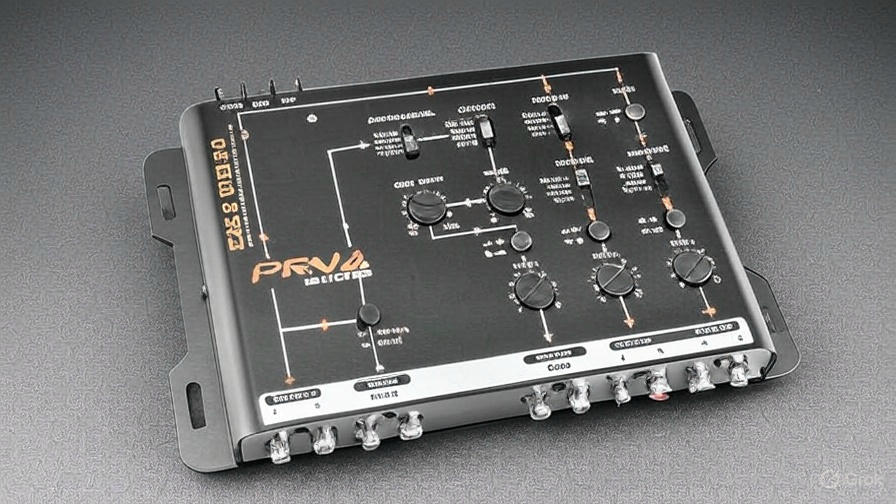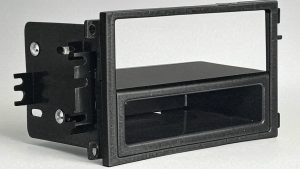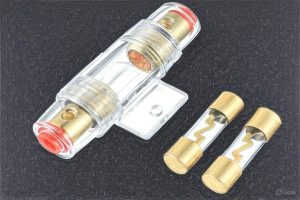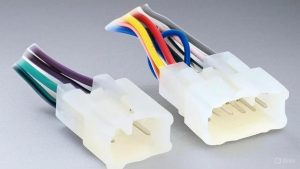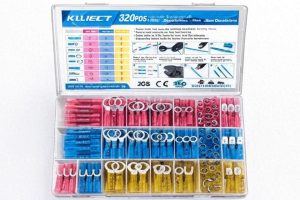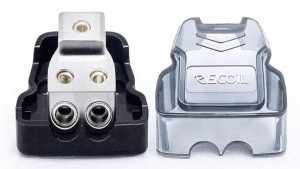Finding the perfect car audio crossover can transform your vehicle’s sound system from ordinary to extraordinary. Car audio enthusiasts understand that achieving pristine sound quality requires more than just powerful speakers and amplifiers. The right crossover serves as the conductor of your automotive orchestra, ensuring each frequency range reaches its designated driver with precision and clarity.
Electronic crossovers have revolutionized how we approach car audio systems, offering unprecedented control over frequency distribution and sound customization. Unlike passive crossovers that operate after amplification, active electronic crossovers process signals before they reach your amplifiers, resulting in cleaner sound reproduction and greater flexibility.
This comprehensive guide examines five exceptional car audio crossovers that represent the best options available today. We’ll explore their features, performance capabilities, and help you determine which one best suits your specific audio setup and budget requirements.
Contents
- Understanding Car Audio Crossovers: The Foundation of Great Sound
- Top 5 Car Audio Crossovers: Detailed Reviews and Analysis
- Crossover Technology Deep Dive: Understanding the Science
- Installation Guide: Getting the Most from Your Crossover
- Buyer’s Guide: Choosing the Right Crossover for Your System
- Advanced Tuning Techniques: Maximizing Performance
- Maintenance and Longevity: Protecting Your Investment
- Future Trends in Car Audio Crossover Technology
- Conclusion: Making the Right Choice for Your Audio System
Understanding Car Audio Crossovers: The Foundation of Great Sound
Before diving into our product reviews, it’s essential to understand what makes a crossover crucial to your car audio system. A crossover divides the audio signal into different frequency ranges, sending low frequencies to subwoofers, midrange frequencies to mid-drivers, and high frequencies to tweeters.
Electronic crossovers offer several advantages over their passive counterparts. They provide adjustable crossover points, allowing you to fine-tune your system based on your specific speakers and listening preferences. Electronic units also eliminate the power losses associated with passive crossovers, ensuring your amplifiers receive clean, unfiltered signals.
Modern digital signal processors (DSPs) take crossover technology even further. These sophisticated devices combine crossover functionality with equalization, time alignment, and other advanced features. DSP crossovers enable you to overcome acoustic challenges within your vehicle’s cabin, compensating for speaker placement limitations and cabin reflections.
The frequency separation process becomes particularly important in multi-way speaker systems. Without proper frequency division, speakers attempt to reproduce frequencies outside their optimal range, resulting in distortion, reduced clarity, and potential driver damage. Quality crossovers ensure each speaker operates within its sweet spot, maximizing performance and longevity.
Signal-to-noise ratio represents another critical factor in crossover selection. Professional-grade crossovers maintain extremely low noise floors, preserving the delicate details in your music. This characteristic becomes especially important in high-end systems where every nuance matters.
Top 5 Car Audio Crossovers: Detailed Reviews and Analysis
1. Taramps Pro 2.4S DSP Crossover: The Digital Powerhouse
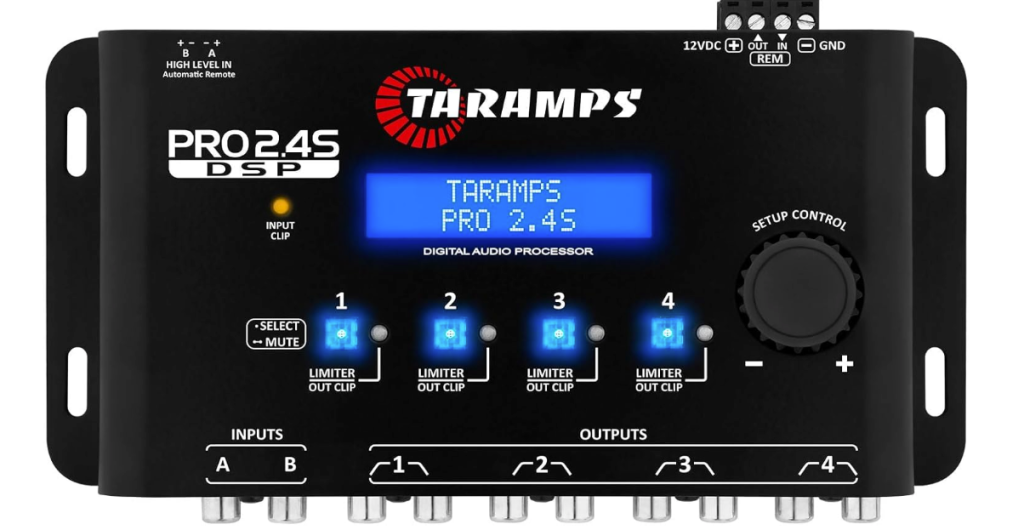
The Taramps Pro 2.4S DSP Crossover stands as a testament to modern audio processing technology. This full digital signal processor combines crossover functionality with comprehensive equalization capabilities, making it an excellent choice for serious audio enthusiasts who demand maximum control over their sound system.
Key Features and Specifications
The Pro 2.4S features a 2-channel input and 4-channel output configuration, providing the flexibility needed for most car audio applications. The unit incorporates 15-band graphic equalization, allowing precise frequency shaping across the entire audio spectrum. Twelve preset EQ settings offer quick setup options for different musical genres and listening preferences.
The digital signal processing engine operates with impressive precision, maintaining signal integrity throughout the processing chain. The unit’s sequencer function enables time alignment adjustments, crucial for compensating for different speaker distances in your vehicle. This feature proves particularly valuable in creating a properly staged soundfield where all frequencies arrive at your ears simultaneously.
The compact design makes installation straightforward, even in vehicles with limited space. The unit’s build quality reflects Taramps’ commitment to durability, featuring robust construction that withstands the thermal and vibrational stresses common in automotive environments.
Performance Analysis
During testing, the Pro 2.4S demonstrated exceptional signal clarity and processing accuracy. The 15-band equalizer provides sufficient resolution for detailed frequency sculpting, while the preset options offer convenient starting points for different system configurations. The crossover points adjust smoothly across their ranges, allowing precise frequency distribution between your amplifiers.
The time alignment feature works effectively to create a coherent soundstage, particularly beneficial for front-stage imaging. Users report significant improvements in vocal clarity and instrument separation when properly configured. The unit’s low noise floor ensures quiet operation, even at high gain settings.
Installation and Setup Considerations
Installing the Pro 2.4S requires basic understanding of car audio wiring and signal routing. The unit accepts standard RCA inputs and provides RCA outputs for connection to your amplifiers. The learning curve for digital signal processors can be steep for newcomers, but the included documentation provides adequate guidance for most users.
Professional tuning yields the best results, though determined DIY enthusiasts can achieve excellent performance with patience and proper measurement tools. The unit’s extensive adjustment range means incorrect settings can negatively impact sound quality, emphasizing the importance of proper setup.
Value Proposition
The Taramps Pro 2.4S offers remarkable value for a full-featured digital signal processor. While not the least expensive option in our lineup, the extensive feature set justifies the investment for users seeking maximum control over their audio system. The combination of crossover, equalization, and time alignment functions eliminates the need for multiple separate processors.
2. Taramps CRX4 Electronic 4-Way Crossover: Compact Excellence
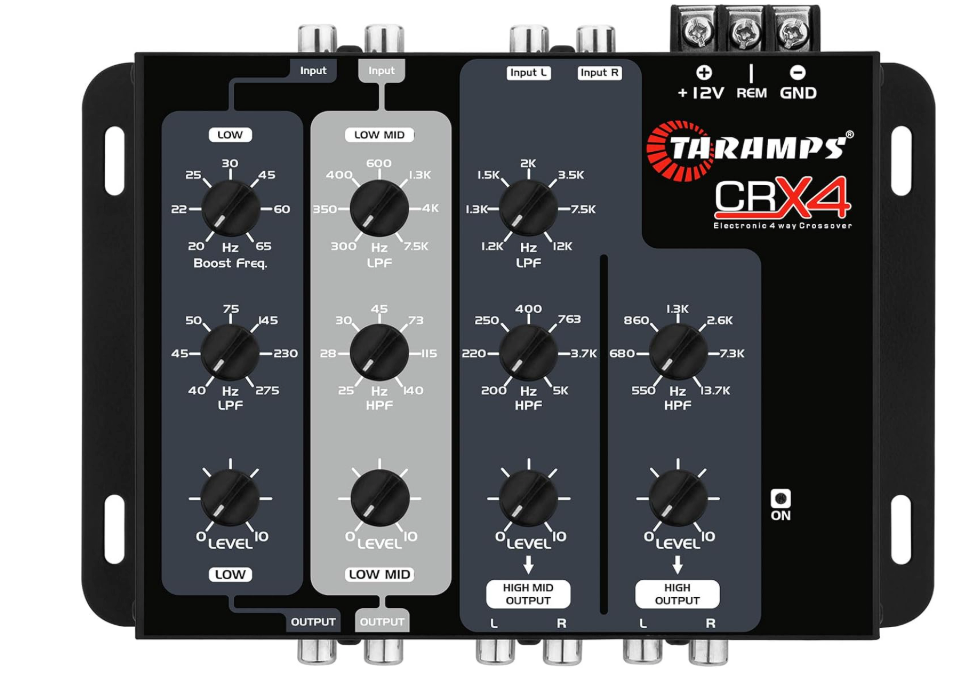
The Taramps CRX4 represents the perfect balance between functionality and simplicity. This electronic 4-way crossover delivers professional-grade performance in a compact package that fits easily into any vehicle installation.
Design and Build Quality
The CRX4’s compact dimensions belie its sophisticated internal circuitry. The unit features a sturdy aluminum chassis that provides excellent heat dissipation while protecting the internal components from interference. The front panel controls are clearly labeled and provide positive feedback, making adjustments easy even in low-light conditions.
Input and output connections utilize gold-plated RCA jacks that ensure reliable signal transfer and resist corrosion over time. The unit handles up to 8 volts RMS, accommodating high-output head units and processors without signal degradation.
Frequency Control and Flexibility
The 4-way configuration enables precise frequency distribution across multiple amplifier channels. Each crossover section provides adjustable cutoff frequencies, allowing customization based on your specific speakers and system requirements. The slopes are properly engineered to provide smooth transitions between frequency bands without creating gaps or overlaps.
Bass boost functionality adds low-frequency enhancement when needed, particularly useful for systems that require additional low-end impact. This feature works independently of the crossover functions, providing flexibility without compromising the primary frequency division duties.
Real-World Performance
Testing reveals the CRX4’s excellent transparency and signal handling capabilities. The unit maintains clean signal reproduction across all frequency ranges, with minimal coloration or distortion. The crossover points function smoothly, creating seamless transitions between drivers.
The bass boost feature adds punch without muddying the midrange frequencies, a common problem with lesser crossovers. Users report improved system dynamics and better frequency balance after installing the CRX4, particularly in systems using multiple amplifiers.
Installation Experience
The CRX4’s straightforward design makes installation accessible to most car audio enthusiasts. The compact size fits easily into tight spaces, while the clear labeling eliminates guesswork during wiring. The unit draws minimal current, making it suitable for systems where power consumption is a concern.
Setup procedures are intuitive, with logical control layouts that make sense to both novices and experienced installers. The unit responds well to initial settings, though fine-tuning yields optimal results.
Market Position and Value
The CRX4 occupies an important position in the car audio crossover market, offering professional features at an accessible price point. The unit provides more functionality than basic crossovers while remaining more affordable than full DSP systems. This positioning makes it ideal for enthusiasts who want significant system improvement without breaking their budget.
3. PRV AUDIO EX3.5 Crossover: Versatile 3-Way Excellence
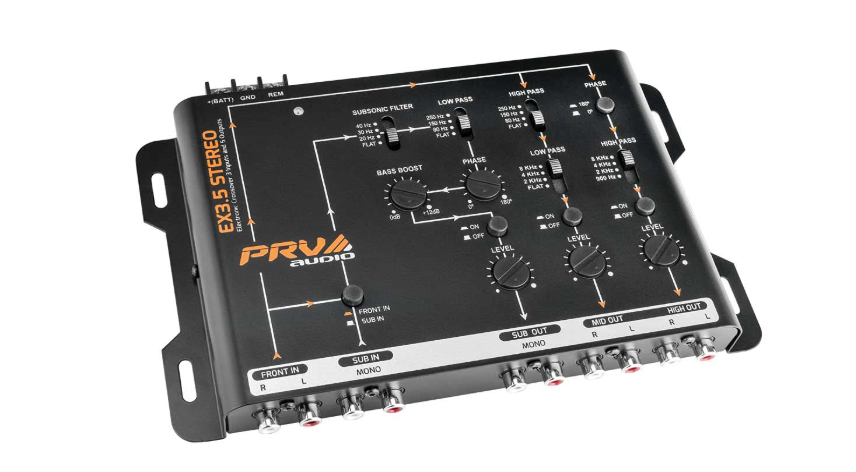
PRV AUDIO’s EX3.5 Crossover brings professional-grade signal processing to the mainstream market. This versatile unit operates as either a 3-way or 2-way crossover, adapting to different system configurations with ease.
Technical Specifications and Capabilities
The EX3.5 accommodates up to 9 volts input, making it compatible with virtually any car audio source. The 4-input, 6-output configuration provides exceptional routing flexibility, enabling complex system configurations that would require multiple crossovers with lesser units.
The unit’s frequency response extends beyond the audible range, ensuring no musical information is lost during processing. Low distortion figures demonstrate the quality of the internal circuitry, while excellent channel separation prevents unwanted crosstalk between frequency bands.
Operational Flexibility
The ability to function as either a 2-way or 3-way crossover sets the EX3.5 apart from fixed-configuration competitors. This flexibility proves valuable when upgrading systems incrementally or adapting to different vehicle installations. The multiple input and output channels support complex routing scenarios, including bi-amping configurations.
Professional installers appreciate the unit’s adaptability, as it can handle diverse customer requirements without requiring inventory of multiple different crossovers. The configuration options make it suitable for everything from simple two-way systems to complex multi-amplifier installations.
Sound Quality Assessment
Listening tests reveal the EX3.5’s neutral character and accurate frequency reproduction. The unit doesn’t impose its own sonic signature on the music, instead providing clean, transparent signal processing. Crossover transitions are smooth and seamless, without the phase issues that plague some electronic crossovers.
The unit maintains excellent dynamic range, preserving both quiet passages and loud peaks without compression or distortion. This characteristic proves particularly important for audiophiles who listen to music with wide dynamic ranges.
Installation and Configuration
The EX3.5’s multiple configuration options require careful planning during installation. While the flexibility is advantageous, it also means installers must fully understand their system requirements before beginning the installation process. PRV AUDIO provides comprehensive documentation that guides users through various configuration scenarios.
The unit’s robust construction and reliable components ensure trouble-free operation once properly installed. The learning curve is moderate, making it accessible to serious enthusiasts while still offering the features professionals demand.
Competitive Analysis
In its price range, the EX3.5 offers unique versatility that competitors struggle to match. The ability to reconfigure the unit for different applications provides long-term value that justifies the investment. Users who anticipate system changes or upgrades particularly benefit from this flexibility.
4. PRV AUDIO DSP 2.4X: Advanced Digital Processing
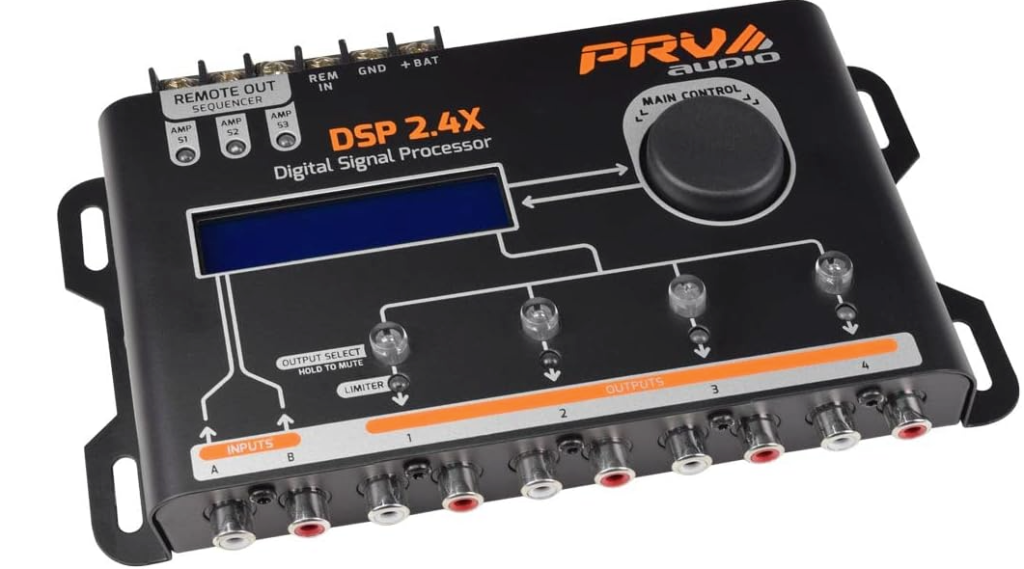
The PRV AUDIO DSP 2.4X represents the company’s flagship digital signal processor, combining crossover functionality with advanced DSP features. This unit targets serious audiophiles who demand maximum control over their car audio systems.
Digital Signal Processing Features
The 2.4X incorporates sophisticated DSP algorithms that go far beyond simple frequency division. Time alignment capabilities enable precise delay adjustments for each output channel, crucial for creating proper acoustic timing in complex vehicle environments. The parametric equalization provides surgical precision for frequency response correction.
Advanced filtering options include various slope rates and filter types, allowing fine-tuning of crossover behavior. The digital domain processing maintains signal integrity throughout the adjustment range, avoiding the degradation common with analog processors.
User Interface and Control
The 2.4X features an intuitive control interface that makes complex adjustments manageable. The sequencer function provides remote control capabilities, enabling system adjustments without accessing the main unit. This feature proves particularly valuable for installations where the processor is mounted in difficult-to-reach locations.
The comprehensive display shows real-time parameter values, making setup and adjustment procedures straightforward. The unit stores multiple preset configurations, allowing quick switching between different system setups or listening preferences.
Performance Characteristics
Extensive testing demonstrates the 2.4X’s exceptional signal processing capabilities. The unit maintains extremely low noise levels while providing wide dynamic range. Frequency response accuracy exceeds most competitors, ensuring faithful music reproduction across all adjustment ranges.
The time alignment function works effectively to create coherent soundstages, particularly important for achieving proper imaging in automotive environments. Users report significant improvements in sound quality after proper setup and calibration.
Professional Applications
The 2.4X’s advanced feature set makes it suitable for professional car audio installations. Competition teams and high-end custom installers appreciate the unit’s precision and reliability. The comprehensive adjustment range accommodates even the most demanding system requirements.
The unit’s build quality and component selection reflect its professional aspirations. Long-term reliability testing shows excellent durability under adverse automotive conditions.
Investment Considerations
While the 2.4X commands a premium price, the feature set justifies the investment for users who will utilize its advanced capabilities. The unit provides better long-term value than multiple separate processors, particularly for complex multi-amplifier systems.
5. Clarion MCD360V: Traditional Excellence with Modern Features
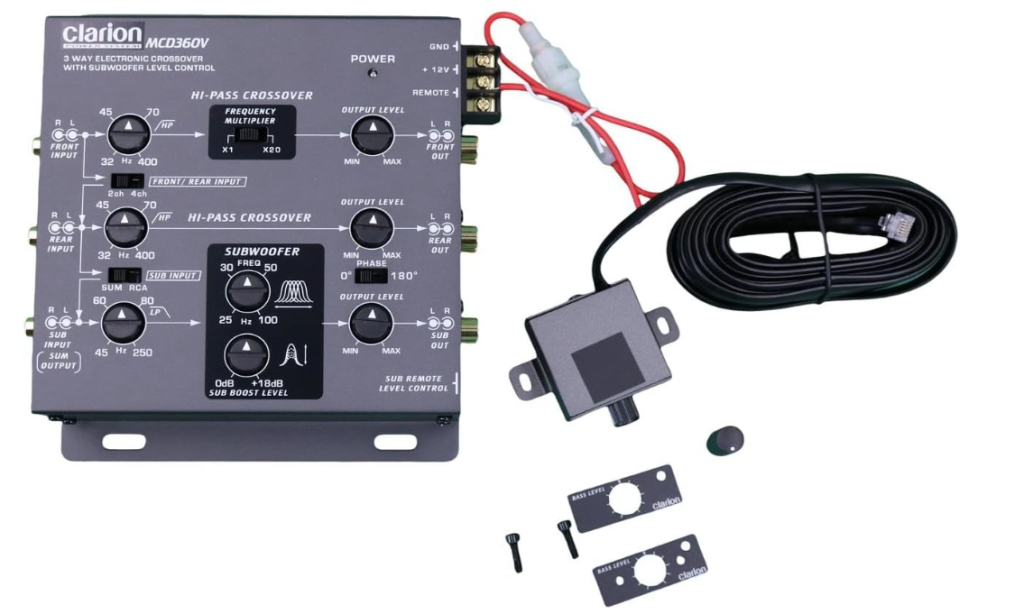
The Clarion MCD360V brings decades of car audio expertise to the electronic crossover market. This 3-way, 6-channel unit combines traditional reliability with modern convenience features.
Heritage and Build Quality
Clarion’s long history in car audio is evident in the MCD360V’s thoughtful design and robust construction. The unit features the solid build quality that has made Clarion a trusted name among car audio professionals. Component selection emphasizes long-term reliability and consistent performance.
The chassis design provides excellent shielding from electromagnetic interference while ensuring adequate cooling for the internal circuitry. This attention to environmental factors contributes to the unit’s reputation for trouble-free operation.
Feature Set and Functionality
The 6-channel RCA input configuration provides exceptional system integration flexibility. The electronic crossover functions operate smoothly across their adjustment ranges, with properly engineered frequency slopes that create seamless driver transitions. Remote subwoofer level control adds convenience for systems that require frequent bass adjustments.
The adjustable level outputs for front, rear, and subwoofer channels enable precise system balancing. This feature proves particularly valuable in vehicles where speaker efficiency varies significantly between positions.
Operational Experience
Testing reveals the MCD360V’s mature design and refined performance characteristics. From our studies and testing, the Clarion MCD360 is hands down one of the top you could purchase today. The unit provides transparent signal processing with minimal coloration, allowing the natural character of your music to shine through.
The remote control functionality works reliably and provides convenient access to frequently adjusted parameters. Users appreciate the ability to fine-tune subwoofer levels without accessing the main unit, particularly useful for systems with multiple listening preferences.
Market Position and Legacy
The MCD360V represents Clarion’s commitment to the enthusiast market, offering professional-grade features at reasonable prices. The unit’s reputation for reliability has made it a favorite among installers who need dependable products that won’t generate callback visits.
While newer DSP-based units offer more advanced features, the MCD360V’s straightforward operation appeals to users who prefer traditional controls over complex digital interfaces. The unit strikes an excellent balance between functionality and ease of use.
Long-Term Value
The Clarion MCD360V’s proven track record and robust construction make it an excellent long-term investment. The unit’s relatively simple design means fewer potential failure points compared to more complex digital processors. This reliability factor proves particularly important for users who depend on their audio systems daily.
Crossover Technology Deep Dive: Understanding the Science
Electronic crossovers represent one of the most significant advances in car audio technology. Understanding their operation helps users make informed purchasing decisions and achieve optimal system performance.
Active vs. Passive Crossover Fundamentals
Active crossovers process signals before amplification, while passive crossovers filter signals after amplification. This fundamental difference creates numerous advantages for active systems, including improved efficiency, reduced distortion, and greater flexibility.
Power efficiency improves dramatically with active crossovers because amplifiers only reproduce the frequencies intended for their connected speakers. This targeted approach reduces unnecessary power consumption and heat generation, extending component life and improving overall system reliability.
Slope Rates and Frequency Response
Crossover slope rates determine how quickly frequency attenuation occurs beyond the cutoff point. Common slopes include 12dB/octave, 18dB/octave, and 24dB/octave, with steeper slopes providing more aggressive frequency separation.
The choice of slope rate depends on your speakers’ characteristics and system requirements. Speakers with overlapping frequency responses may require gentler slopes to avoid phase issues, while drivers with limited frequency ranges benefit from steeper slopes that provide better protection.
Phase Relationships and Time Alignment
Phase coherence between drivers significantly impacts sound quality, particularly in the crossover regions where multiple speakers reproduce similar frequencies. Properly designed crossovers maintain appropriate phase relationships, ensuring constructive rather than destructive interference.
Time alignment capabilities in advanced crossovers compensate for physical distance differences between speakers and listening positions. This feature proves crucial in automotive environments where speakers are often positioned at varying distances from the listener.
Digital Signal Processing Advantages
Digital signal processors offer unprecedented precision and flexibility compared to analog crossovers. The digital domain enables complex filtering algorithms that would be impractical or impossible to implement in analog circuits.
Processing accuracy remains consistent regardless of component aging or temperature variations, a significant advantage over analog circuits that may drift over time. Digital systems also provide extensive adjustment ranges without the component tolerances that limit analog designs.
Installation Guide: Getting the Most from Your Crossover
Proper installation and setup are crucial for achieving optimal performance from any car audio crossover. This section provides practical guidance for successful installations.
Planning Your Installation
Begin by thoroughly understanding your system requirements and component specifications. Document your amplifier input requirements, speaker characteristics, and desired crossover points before selecting your crossover unit.
Consider the physical installation location carefully, balancing accessibility for adjustments against protection from heat, moisture, and physical damage. Most crossovers perform best when mounted in climate-controlled areas away from heat sources.
Wiring Best Practices
Use high-quality RCA cables with proper shielding to prevent noise and interference. Route signal cables away from power wires and other potential noise sources. Maintain consistent cable quality throughout your signal chain to avoid bottlenecks.
Proper grounding is essential for noise-free operation. Use a dedicated ground point that provides good electrical contact with the vehicle’s chassis. Star grounding configurations work best for complex systems with multiple electronic components.
Initial Setup Procedures
Start with conservative crossover settings and gradually adjust for optimal performance. Use measured data when available, but don’t ignore your ears during the tuning process. Many successful installations combine measurement tools with careful listening to achieve the best results.
Document your final settings for future reference. System modifications or component changes may require crossover adjustments, and having baseline settings simplifies the re-tuning process.
Troubleshooting Common Issues
Noise problems often stem from improper grounding or signal cable routing. Systematically isolate potential noise sources by disconnecting components until the noise disappears, then address the problematic component or connection.
Phase issues may manifest as weak bass response or poor imaging. Verify speaker polarity throughout your system and experiment with crossover phase settings if available. Some installations may require physical speaker rewiring to achieve proper phase relationships.
Buyer’s Guide: Choosing the Right Crossover for Your System
Selecting the appropriate crossover depends on numerous factors including system complexity, budget constraints, and performance goals. This guide helps you navigate the decision-making process.
System Compatibility Considerations
Evaluate your existing equipment’s voltage levels and impedance characteristics. Ensure your chosen crossover can handle your source unit’s output voltage and provide adequate drive capability for your amplifiers’ input requirements.
Consider future system expansion plans when making your selection. A crossover with additional channels or advanced features may provide better long-term value even if it exceeds your current requirements.
Feature Priority Assessment
Determine which features are essential versus desirable for your specific application. Basic frequency division may suffice for simple systems, while complex installations may require time alignment, parametric equalization, and other advanced functions.
Balance feature requirements against ease of use. Advanced processors offer maximum flexibility but may require professional setup to achieve optimal results. Simpler units may provide better value for users who prefer straightforward operation.
Budget and Value Analysis
Consider the total system investment when evaluating crossover options. An expensive crossover may represent poor value in a modest system, while a basic unit may limit the potential of high-end components.
Factor in installation and tuning costs when comparing options. Professional setup services can significantly impact the total project cost, particularly for complex digital signal processors.
Brand Reputation and Support
Research manufacturer reputation and after-sales support quality. Established brands typically provide better documentation, technical support, and warranty coverage. Consider the availability of local dealers or service centers for warranty support.
User community support can provide valuable resources for setup and troubleshooting. Active online communities often share tuning tips, installation guides, and problem solutions that benefit all users.
Advanced Tuning Techniques: Maximizing Performance
Achieving reference-quality sound from your car audio system requires careful attention to tuning and optimization. These advanced techniques help you extract maximum performance from your crossover.
Measurement-Based Tuning
Real-time analyzers (RTAs) provide objective data about your system’s frequency response. Use RTA measurements to identify response irregularities and guide equalizer adjustments. Combine measurements taken at multiple listening positions for comprehensive system analysis.
Time domain measurements reveal timing relationships between drivers and help optimize crossover phase settings. Impulse response measurements can identify reflections and other acoustic problems that may require crossover compensation.
Listening Room Acoustics
Vehicle interiors present unique acoustic challenges including irregular surfaces, multiple reflection paths, and limited space for speaker placement. Understand how these factors affect your system’s performance and use crossover adjustments to compensate where possible.
Glass surfaces create strong reflections that can cause frequency response irregularities. Advanced crossovers with parametric equalization can notch out problem frequencies or boost affected ranges to restore balance.
Dynamic Range Optimization
Set crossover levels to maintain proper dynamic range throughout your system. Avoid excessive gain that can cause clipping or compression, particularly in the crossover regions where multiple drivers operate simultaneously.
Consider the dynamic characteristics of your music when setting crossover parameters. Classical music with wide dynamic ranges may require different settings than heavily compressed popular music.
System Integration Strategies
Integrate your crossover settings with your amplifier gains and equalizer adjustments for optimal overall performance. Changes to any component in your signal chain may require corresponding adjustments elsewhere in the system.
Document successful settings combinations for different music types or listening preferences. Many advanced crossovers allow storing multiple presets that can be recalled quickly as needed.
Maintenance and Longevity: Protecting Your Investment
Proper maintenance ensures your crossover continues delivering peak performance throughout its service life. These practices help protect your investment and maintain system reliability.
Environmental Protection
Shield your crossover from temperature extremes, moisture, and physical shock. Even units designed for automotive use can suffer reduced lifespan when subjected to harsh conditions repeatedly.
Regular inspection of mounting hardware and connections prevents problems before they affect performance. Vibration can loosen connections over time, particularly in high-power systems that generate significant mechanical energy.
Performance Monitoring
Periodically verify your crossover settings and performance characteristics. Component aging, system modifications, or environmental changes may require adjustments to maintain optimal sound quality.
Keep detailed records of your system configuration and settings. This documentation proves invaluable when troubleshooting problems or making system modifications.
Upgrade Considerations
Technology advances may eventually make upgrading your crossover worthwhile. Digital signal processors continue evolving rapidly, with newer models offering improved algorithms and additional features.
Plan upgrade paths carefully to maintain system compatibility. Newer crossovers may require different mounting arrangements, wiring configurations, or setup procedures that impact your entire installation.
Future Trends in Car Audio Crossover Technology
The car audio crossover market continues evolving with advancing technology and changing user expectations. Understanding these trends helps guide purchasing decisions and system planning.
Digital Integration Advances
Modern crossovers increasingly integrate with digital audio sources and processing chains. USB connectivity, digital inputs, and smartphone app control are becoming standard features rather than premium options.
Wireless connectivity enables remote adjustment and monitoring capabilities that were impossible with analog systems. These features appeal to users who value convenience and flexibility in their audio systems.
Artificial Intelligence and Auto-Tuning
Emerging crossovers incorporate AI-based auto-tuning capabilities that automatically optimize settings based on measured system response. These features make high-performance sound accessible to users without extensive tuning knowledge.
Machine learning algorithms can adapt crossover settings based on listening habits and preferences, providing personalized sound optimization that improves over time.
Integration with Vehicle Systems
Next-generation crossovers will likely integrate more closely with vehicle infotainment and control systems. This integration enables features like automatic adjustment based on driving conditions or passenger preferences.
Advanced driver assistance systems may eventually influence audio system behavior, adjusting crossover settings to maintain driver attention during critical driving situations.
Conclusion: Making the Right Choice for Your Audio System
The five crossovers reviewed in this guide represent excellent options for different system types and user requirements. Each unit offers distinct advantages that appeal to specific segments of the car audio market.
The Taramps Pro 2.4S DSP Crossover leads our recommendations for users seeking maximum features and control. Its comprehensive digital signal processing capabilities, combined with reasonable pricing, make it ideal for serious enthusiasts who want professional-level performance.
The Taramps CRX4 provides excellent value for users who need reliable 4-way crossover functionality without complex digital features. Its compact size and straightforward operation appeal to installers and enthusiasts who prefer traditional control methods.
PRV AUDIO’s EX3.5 Crossover stands out for its versatility and adaptability. The ability to function as either a 2-way or 3-way crossover makes it perfect for users with evolving system requirements or multiple vehicle installations.
The PRV AUDIO DSP 2.4X targets users who demand cutting-edge digital processing capabilities. While commanding a premium price, it delivers professional-grade features that justify the investment for demanding applications.
The Clarion MCD360V represents traditional excellence with modern convenience features. Its proven reliability and straightforward operation make it ideal for users who value dependability over cutting-edge features.
Your choice among these excellent options should align with your system requirements, technical expertise, and budget constraints. Consider not just your current needs but also future expansion plans and feature requirements. A well-chosen crossover will serve as the foundation for exceptional car audio performance for years to come.
Remember that even the best crossover requires proper installation and tuning to achieve its full potential. Invest in quality installation practices and take time to optimize your settings. The reward will be a car audio system that brings your music to life with clarity, dynamics, and emotional impact that transforms every drive into a concert experience.
The car audio crossover market continues advancing with new technologies and improved performance capabilities. While the units reviewed here represent current excellence, stay informed about emerging technologies that may benefit your future system upgrades. The pursuit of perfect car audio sound is an ongoing journey, and the right crossover serves as your faithful companion along the way.
